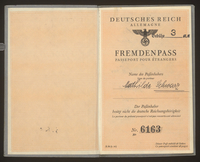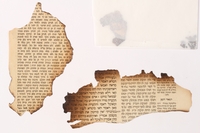Overview
- Brief Narrative
- Bound Torah brought to the United States by 16-year-old Mathilde (Tilli) Schwarz (later Rosenblatt) in February 1940, when she emigrated from Vienna, Austria. Pressed between the pages of the book, Mathilde carried photos of her parents, Gershom and Rachel, and two burned fragments of Talmudic commentary she recovered during the Kristallnacht pogrom of November 9-10, 1938. Mathilde lived in Vienna with her parents and older sister, Estera (Bertha.) On March 13, 1938, Germany annexed Austria and created new legislation that restricted Jewish life. In July, Mathilde’s sister, Estera, married Berthold Stoeckel. During Kristallnacht, Mathilde watched from her apartment as synagogues and Jewish businesses were attacked, and Jewish religious texts were burned across the city. In late December, Estera and Berthold immigrated to the US. In January 1939, Mathilde received an alien passport for the German Reich. Not long after, she and her parents escaped to Częstochowa, Poland. Later in the year, Mathilde was allowed to return alone to Vienna, and gather the required documentation for her anticipated immigration to the US. On September 1, 1939, Germany invaded Poland. On December 30, Mathilde renewed her passport. On February 3, 1940, Mathilde received a US visa, and two days later bought a train ticket to Rotterdam, Netherlands. On February 10, Mathilde boarded the SS Volendam and sailed to the US, where she reunited with Estera. On May 1, 1945, Mathilde married Samuel Rosenblatt, a fellow Viennese émigré. Mathilde later learned that both her parents were murdered during the Holocaust.
- Title
- Chamisha Chushei Torah
- Alternate Title
- Five Books of the Torah
Die fünf Bücher Mose
The Five Books of Moses - Date
-
publication:
1922
emigration: 1940 February 10-1940 February 22
- Geography
-
publication:
Berlin (Germany)
en route: United States
- Credit Line
- United States Holocaust Memorial Museum Collection, Gift of Robert and Steven Rosenblatt
- Markings
- spine, gilt, gold leaf : Hebrew characters [Torah]
- Contributor
-
Subject:
Mathilde Rosenblatt
Author: Meir H. Latris
Publisher: Trowitzsch & Sohn
- Biography
-
Mathilde Schwarz (Tilli, 1923-2014, later Rosenblatt) was born in Vienna, Austria, to Gershom (Gershon) Ovodje (1887-1942?) and Rachel Lieberman (1893-1942?) Schwarz. Gershom was born to Mendel and Gendla (Hendil) Lewkowicz Schwarz in Piotrkow Trybunalski, Poland. Gershom was a jeweler by trade, and ran his own business, Graveur Schwarz. Rachel (Ruchla or Rosa) was born to Izrael Dawid and Alta Nacha Laskowska Liberman in Kruszyna, Poland. On May 1, 1913, Gershom and Rachel married in Częstochowa, Poland. Mathilde had one sister, Estera (Bertha) Bronia (later Stoeckel, 1914-1988,) born in Tomaszow Mazowiecki, Poland. By 1915, Gershom and Rachel had moved their family to Vienna, where he was registered as a goldsmith. As an adult, Estera worked as a milliner.
In 1935, there was a growing movement supporting the German state under Adolf Hitler and Austrians began advocating for the Nazi party, as well as an increase in anti-Jewish policies. On March 13, 1938, Austria was annexed into Germany, in what became known as the "Anschluss." The Germans quickly introduced anti-Jewish legislation. On July 31, 1938, Estera married Berthold Stoeckel (1914-?) in Vienna, where he had been born. He was a merchant. During the Kristallnacht pogrom of November 9-10, Mathilde thought it was snowing and ran outside onto her apartment balcony in excitement. Once she was outside, she realized that the falling bits were actually charred and torn pages from Jewish scripture that was being burned throughout the city. Her mother quickly pulled her inside for safety. Mathilde did not understand what was happening, or why, but she knew it was terrible. Mathilde recovered two burned pieces of scripture, and decided to keep them because she knew they were sacred and she was very religious. At the end of 1938, Estera and Berthold travelled to Cherbourg, France, where they boarded the SS Franconia and sailed to the United States. On January 2, 1939, the young couple arrived in New York City, and were met by a relative, Alex Weiskopf.
On January 26, 1939, Mathilde was issued an alien passport for the German Reich. It was valid for a year and allowed for re-entry to the Reich. Not long after, Mathilde and her parents, Gershom and Rachel, escaped to Częstochowa, Poland, where Rachel had family. Later in the year, Mathilde was allowed to return alone to Vienna, and gather required documentation for her anticipated immigration to the US. On September 1, 1939, Germany invaded Poland, beginning World War II. Two days later, German forces were in Częstochowa. On September 4, a false accusation of a Jew opening fire on German soldiers brought on a vicious pogrom that claimed more than 1000 lives and came to be known as “Bloody Monday.”
While in Vienna, Mathilde was homeless and living on the streets much of the time. Sometimes an old neighbor would provide Mathilde with some assistance, but they did not have enough food to feed themselves or her most of the time. On December 30, Mathilde renewed her passport with the Police Chief of Vienna, which extended its validity through December 20, 1940. On January 29, 1940, Mathilde received a stamped visa for a single re-entry into the Reich via a German transit point before February 12. On February 3, Mathilde received a US visa through the embassy in Vienna. On February 5, with the money she had sewn into her clothing, Mathilde bought a train ticket to Rotterdam, Netherlands, via the shortest possible route. The following day, she received a travel allowance stamp for 3.80 RM from the bank. Mathilde left shortly after, reaching the German border crossing at Emmerich, and the transit station at Zevenaar, Netherlands, on February 8. Two days later, Mathilde boarded the SS Volendam and sailed to the US, arriving in New York City on February 22.
Once she was settled in the US, Mathilde’s sister drove her to a Jewish singles dance at the Roosevelt Hotel on Madison Avenue. She met Samuel Rosenblatt (Sam, 1914-1982), a fellow émigré from Vienna, at the dance. He had been born in Trybuchowce, Austria-Hungary (now Trybukhivtsi Ukraine,) to Wolfe and Sophie (1882-1927) Rosenblatt, but he was raised in Vienna. Samuel had five older siblings. After Samuel’s mother died, his father married Frieda. In the late 1930’s, Samuel made his way to Belgium, and eventually emigrated, arriving in the US on November 11, 1939, with his brother-in-law Hirsch. On May 1, 1945, Mathilde married Sam in Washington, D.C. On May 7, 1945, Germany surrendered, ending the war in Europe. Mathilde learned that her mother was likely sent to the Warsaw ghetto and died at Majdanek killing center, and that her father was also murdered. Samuel learned that all of his siblings survived. Mathilde and Samuel settled down and had two sons. Samuel worked as an electrical contractor, and Mathilde was a homemaker. Mathilde was an avid Zionist, attended shul regularly, and visited Israel several times. Following Sam’s death in 1982, Mathilde spent much of her time volunteering in her community.
Physical Details
- Classification
-
Books and Published Materials
- Category
-
Books and pamphlets
- Object Type
-
Judaism--Prayer books (lcsh)
- Genre/Form
- Religious books.
- Extent
-
1 folder
- Physical Description
- Book; 350 p.; 21.5 cm.
Diamond textured, black paper binding with gold, gilded, lettering on the upper portion of the black, cloth-covered spine. There is a rectangular, nested line border embossed on the front and back covers with a large oval around the center, and floral scrollwork decoration in the corners. The Hebrew and German text is printed in black ink on medium-weight tan paper with marbled edges. - Dimensions
- overall: Height: 8.500 inches (21.59 cm) | Width: 7.125 inches (18.097 cm) | Depth: 0.750 inches (1.905 cm)
- Materials
- overall : paper, ink, gold leaf, cardboard, cloth
Rights & Restrictions
- Conditions on Access
- No restrictions on access
- Conditions on Use
- No restrictions on use
Keywords & Subjects
- Topical Term
- Kristallnacht, 1938--Austria. Holocaust, Jewish (1939-1945)--Austria--Vienna--Personal narratives. Austria--Emigration and immigration--History--20th century. Jews--Persecutions--Austria. Holocaust, survivors--United States--Biography. Offenses against religion--Austria. Cze̜stochowa (Poland)--Ethnic relations--History--20th century. Judaism--Liturgy--Texts.
- Geographic Name
- Vienna (Austria) Częstochowa (Poland) Netherlands. United States.
Administrative Notes
- Legal Status
- Permanent Collection
- Provenance
- The Chumash was donated to the United States Holocaust Memorial Museum in 2015 by Robert and Steven Rosenblatt, the sons of Mathilde Schwarz Rosenblatt.
- Funding Note
- The cataloging of this artifact has been supported by a grant from the Conference on Jewish Material Claims Against Germany.
- Record last modified:
- 2022-07-28 18:12:21
- This page:
- https://collections.ushmm.org/search/catalog/irn526981
Download & Licensing
In-Person Research
- By Appointment
- Request 21 Days in Advance of Visit
- Plan a Research Visit
- Request to See This Object
Contact Us
Also in Mathilde Schwarz Rosenblatt collection
The collection consists of burnt page fragments from Hebrew books, a Pentatuch, documents, and photographs relating to the experiences of Mathilde Schwarz Rosenblatt before and during the Holocaust in Vienna, Austria.
Date: approximately 1922-1940

Mathilde Schwarz Rosenblatt photographs and passport
Document
This papers includes a passport issued to Mathilde Schwarz and two photographs of her parents, Gershon and Rachel Schwarz. Mathilde immigrated to the United States in 1940, leaving her parents behind in Vienna.

Burned fragments Talmudic commentary recovered during Kristallnacht by a Jewish Austrian girl
Object
Burned fragments of Talmudic commentary on the Shabbat chapter by Rif (Rabbi Isaac Alfasi) and Rabbeinu Nissim recovered by Mathilde Schwarz (later Rosenblatt) during the Kristallnacht pogrom of November 9-10, 1938. She brought the fragments with her to the United States in February 1940, when she emigrated from Vienna, Austria, to live with her older sister, Estera. Mathilde lived in Vienna with her parents, Gershom and Rachel, and Estera (Bertha.) On March 13, 1938, Germany annexed Austria and created new legislation that restricted Jewish life. In July, Estera, married Berthold Stoeckel. During Kristallnacht, Mathilde watched from her apartment as synagogues and Jewish businesses were attacked, and Jewish religious texts were burned across the city. In late December, Estera and Berthold immigrated to the US. In January 1939, Mathilde received an alien passport for the German Reich. Not long after, she and her parents escaped to Częstochowa, Poland. Later in the year, Mathilde was allowed to return alone to Vienna, and gather the required documentation for her anticipated immigration to the US. On September 1, 1939, Germany invaded Poland. On December 30, Mathilde renewed her passport. On February 3, 1940, Mathilde received a US visa, and two days later bought a train ticket to Rotterdam, Netherlands. On February 10, Mathilde boarded the SS Volendam and sailed to the US, where she reunited with Estera. On May 1, 1945, Mathilde married Samuel Rosenblatt, a fellow Viennese émigré. Mathilde later learned that both her parents were murdered during the Holocaust.



